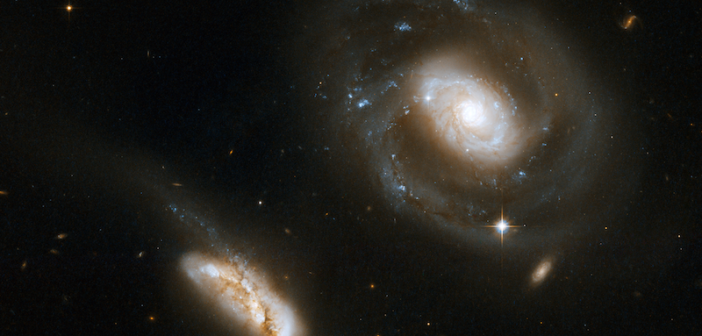Editor’s Note: Astrobites is a graduate-student-run organization that digests astrophysical literature for undergraduate students. As part of the partnership between the AAS and astrobites, we occasionally repost astrobites content here at AAS Nova. We hope you enjoy this post from astrobites; the original can be viewed at astrobites.org.
Title: GOALS-JWST: Resolving the Circumnuclear Gas Dynamics in NGC 7469 in the Mid-Infrared
Authors: Vivian U et al.
First Author’s Institution: University of California, Irvine
Status: Published in ApJL
As supermassive black holes accrete matter, they often like to blow off some steam in the form of outflows. Supermassive black holes are thought to power active galactic nuclei, which are often obscured by dust. Astronomers are interested in how active galactic nucleus outflows impact a galaxy’s interstellar medium and to what extent outflows could trigger or halt star formation in the interstellar medium. Since active galactic nuclei are often dusty, obscuration has made it difficult to study outflows — at least, until JWST came onto the scene.
Today’s authors inspect NGC 7469, a nearby galaxy uniquely suited for studying the relationship between active galactic nucleus outflows and star formation. NGC 7469 contains a Seyfert nucleus surrounded by a ring with active star formation, and previous observations show evidence of outflows. With new spectroscopy from JWST, the authors take a detailed look at how the gas and dust of NGC 7469 are affected by outflows.
Hunting for Outflows with Spectroscopy
With mid-infrared integral field spectroscopy from JWST’s Mid-InfraRed Instrument (MIRI), the authors use several emission lines to study where outflows occur and how they interact with the interstellar medium. In Figure 1, a map of the flux for [Fe II], H2, and [Ar II] emission lines reveals that the H2 flux, from molecular gas, is mostly concentrated around the nucleus, while [Fe II] and [Ar II], forbidden lines emitted from ionized gas, are brightest in the ring of NGC 7469.

Figure 1: Regions of the ring and the nucleus of NGC 7469 are bright in [Fe II] and [Ar II] while H2 is mainly bright in the nucleus. [Adapted from U et al. 2022]

Figure 2: Top left: A grid of the regions where spectra were taken on top of an image of NGC 7469, with the different regions labeled according to their direction relative to the center. Bottom: The spectra from all nine regions, with spectral lines labeled. Top right: The spectra zoomed in around the [Mg V] emission line. The spectrum taken in the region east of the center is shown in turquoise, and its peak is blueshifted relative to the spectrum from the central region. [U et al. 2022]
How Do Outflows Affect the Interstellar Medium?

Figure 3: The ratio of the brightness of an H2 emission line to the brightness of a PAH emission line at 6.2 microns is plotted as a function of the density of brightness in H2 for nine regions around the center of NGC 7469. [Adapted from U et al. 2022]
With new JWST data, today’s authors took a high-resolution view of the gas and dust around NGC 7469’s nucleus and found that an active galactic nucleus outflow appears to interact with its interstellar medium. As high-resolution spectroscopy from JWST allows astronomers to study active galactic nuclei and their outflows in unprecedented detail, surely more will be discovered about the role of active galactic nuclei in regulating star formation.
About the author, Sarah Bodansky:
I’m a first-year graduate student at the University of Massachusetts Amherst studying galaxies. My current research is focused on using observations to better understand the evolution of dust mass in star-forming galaxies. Outside of research, I enjoy reading, cooking, and hanging out with my cat.
